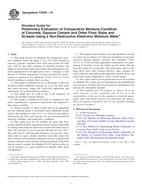Potřebujeme váš souhlas k využití jednotlivých dat, aby se vám mimo jiné mohly ukazovat informace týkající se vašich zájmů. Souhlas udělíte kliknutím na tlačítko „OK“.
ASTM F2659-10
Standard Guide for Preliminary Evaluation of Comparative Moisture Condition of Concrete, Gypsum Cement and Other Floor Slabs and Screeds Using a Non-Destructive Electronic Moisture Meter
Automaticky přeložený název:
Standardní Průvodce pro předběžné vyhodnocení Srovnávací vlhkosti stavu z betonu, sádry cementu a jiných podlahových desek a stěrek Použití nedestruktivní Electronic vlhkoměr
NORMA vydána dne 1.7.2010
Informace o normě:
Označení normy: ASTM F2659-10
Poznámka: NEPLATNÁ
Datum vydání normy: 1.7.2010
Kód zboží: NS-54328
Počet stran: 6
Přibližná hmotnost: 18 g (0.04 liber)
Země: Americká technická norma
Kategorie: Technické normy ASTM
Anotace textu normy ASTM F2659-10 :
Keywords:
anhydrite, comparative moisture content, concrete, dew point, flooring, floor slabs, gypsum, moisture, moisture content, moisture emission, moisture equilibrium, moisture vapor, relative humidity, temperature, Flooring/floor covering systems (concrete), Gypsum cement, Moisture analysis--concrete, Moisture meter, ICS Number Code 91.060.30 (Ceilings. Floors. Stairs)
Doplňující informace
| Significance and Use | ||||||||
|
Moisture in concrete floor slabs affects the performance of flooring systems such as resilient, wood, and textile floor coverings and coatings. Manufacturers of such systems generally require moisture testing be performed before installation of coverings on floor slabs and screeds. The measurement of sub-surface comparative moisture condition in the upper 1.0 in. (25.4 mm) stratum of a concrete slab with a non-destructive moisture meter is one such method. Excessive moisture in floor slabs after installation can cause floor covering system failures such as delamination, bonding failure, deterioration of finish flooring and coatings, and microbial growth. |
||||||||
| 1. Scope | ||||||||
|
1.1 This guide focuses on obtaining the comparative moisture condition within the upper 1.0 in. (25.4 mm) stratum in concrete, gypsum, anhydrite floor slabs and screeds for field tests. Due to the wide variation of material mixtures and additives used in floor slabs and screeds, this methodology may not be appropriate for all applications. See 1.2 through 1.8 and Section 11. Where appropriate or when specified use further testing as outlined in Test Methods F1869, F2170 or F2420 before installing a resilient floor covering. 1.2 This guide is intended for use to determine if there are moisture-related conditions existing on, or in, the floor slabs that could adversely impact the successful application and performance of resilient flooring products. 1.3 This guide may be used to aid in the diagnosis of failures of installed resilient flooring. 1.4 This guide is intended to be used in conjunction with meter manufacturer’s operation instructions and interpretive data where available. 1.5 Where possible, or when results need to be quantified use this standard guide to determine where additional testing such as Test Methods F1869, F2170, or F2420 as specified to characterize the floor slab and the test area environment for moisture, humidity and temperature conditions. 1.6 This guide may not be suitable for areas that have surface applied moisture migration systems, curing compounds or coatings that cannot be removed or cleaned off sufficiently to allow the moisture to move upwards through the slab. For a floor slab of 6 in. (150 mm) plus thickness, low porosity slabs, slabs with no vapor retarder installed, and slabs where the above surface environmental conditions can have a greater than normal influence on the moisture reduction gradient of the floor slab or screed, consider Test Method F2170 (below surface in situ rh method) as a more suitable test method under these circumstances. 1.7 This guide is not intended to provide quantitative results as a basis for acceptance of a floor for installation of moisture sensitive flooring finishes systems. Test Methods F1869, F2170, or F2420 provide quantitative information for determining if moisture levels are within specific limits. Results from this guide do not provide vital information when evaluating thick slabs, slabs without effective vapor retarders directly under the slab, lightweight aggregate concrete floors, and slabs with curing compound or sealers on the surface. 1.8 The values stated in inch-pound units are to be regarded as standard. The values given in parentheses are mathematical conversions to SI units that are provided for information only and are not considered standard. 1.9 This standard does not purport to address all of the safety concerns, if any, associated with its use. It is the responsibility of the user of this standard to establish appropriate safety and health practices and determine the applicability of regulatory limitations prior to use. Specific warnings are given in Section 7. |
||||||||
| 2. Referenced Documents | ||||||||
|
Doporučujeme:
Aktualizace technických norem
Chcete mít jistotu, že používáte pouze platné technické normy?
Nabízíme Vám řešení, které Vám zajistí měsíční přehled o aktuálnosti norem, které používáte.
Chcete vědět více informací? Podívejte se na tuto stránku.




 Cookies
Cookies
